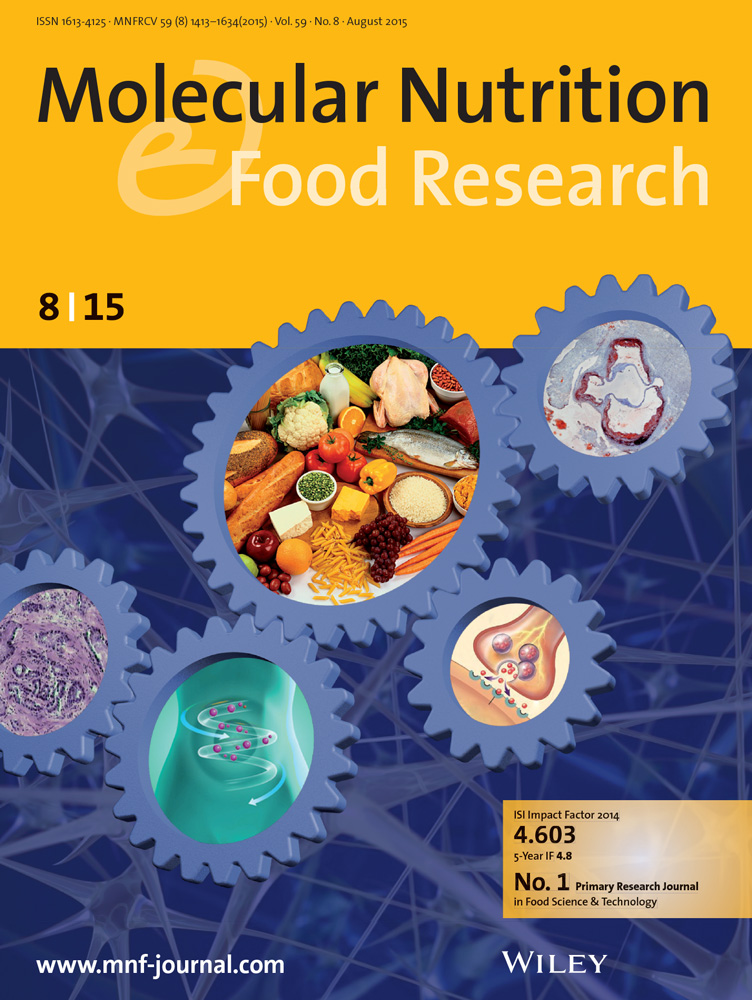HLA - DQ8转基因小鼠的高脂饮食-小麦面筋相互作用
IF 4.2
2区 农林科学
Q1 FOOD SCIENCE & TECHNOLOGY
引用次数: 0
摘要
在几种情况下,不平衡的脂质代谢会导致炎症。引发乳糜泻的麸质也可能在与高脂肪饮食(HFD)相关的疾病中发挥作用。我们的目的是在HLA - DQ8转基因小鼠(谷蛋白敏感性模型)中研究谷蛋白和HFD之间的相互作用。DQ8小鼠被喂食无麸质饮食、HFD或含有8%麸质(HFD + G)的HFD,为期12周或23周。评估临床指标、肝脏和肠道组织学、免疫指标。12周的HFD增加了雄性DQ8小鼠的体和白色脂肪组织重量,降低了葡萄糖耐量。麸质增加高胰岛素血症和肝脏脂质积累;干扰素γ (IFN‐γ)和白细胞介素- 10 (IL‐10)转录物在HFD + G‐喂养小鼠的肝脏中较高。在HFD + G‐喂养小鼠的小肠中,IL‐1β、肿瘤坏死因子α (TNF‐α)、IFN‐γ和IL‐10 mrna增加。然而,麦胶蛋白特异性免疫和肠道结构的改变未被诱导。饲喂HFD + G 23周后,面筋效应减弱。12周后发现谷蛋白和HFD之间存在协同效应,这有助于改变DQ8小鼠的特定代谢和免疫功能。这些发现为剖析肥胖和麸质敏感性之间的关系提供了有用的新见解。本文章由计算机程序翻译,如有差异,请以英文原文为准。
High‐Fat Diet–Wheat Gluten Interactions in HLA‐DQ8 Transgenic Mice
Unbalanced lipid metabolism contributes to inflammation in several conditions. Gluten, that triggers celiac disease, may also play a role in diseases associated with a high‐fat diet (HFD). Our aim was to investigate the interplay between gluten and HFD in HLA‐DQ8 (DQ8) transgenic mice, a model of gluten sensitivity. DQ8 mice were fed the gluten‐free diet, the HFD, or the HFD containing 8% gluten (HFD + G) for 12 or 23 weeks. Clinical parameters, liver and intestinal histology, immune parameters were assessed. Twelve weeks of HFD increased body and white adipose tissue weight and reduced glucose tolerance in male DQ8 mice. Gluten increased hyperinsulinemia and lipid accumulation in liver; interferon gamma (IFN‐γ) and interleukin‐10 (IL‐10) transcripts were higher in liver of HFD + G‐fed mice. IL‐1β, tumor necrosis factor‐α (TNF‐α), IFN‐γ, and IL‐10 mRNAs increased in the small intestine of HFD + G‐fed mice. However, gliadin‐specific immunity and alterations of the intestinal architecture were not induced. Feeding HFD + G for 23 weeks attenuated the gluten effect. A synergic effect between gluten and HFD after 12 weeks was found, which was instrumental to alter specific metabolic and immune functions in DQ8 mice. These findings provide new insights useful to dissect the association between obesity and gluten sensitivity.
求助全文
通过发布文献求助,成功后即可免费获取论文全文。
去求助
来源期刊

Molecular Nutrition & Food Research
工程技术-食品科技
CiteScore
8.70
自引率
1.90%
发文量
250
审稿时长
1.7 months
期刊介绍:
Molecular Nutrition & Food Research is a primary research journal devoted to health, safety and all aspects of molecular nutrition such as nutritional biochemistry, nutrigenomics and metabolomics aiming to link the information arising from related disciplines:
Bioactivity: Nutritional and medical effects of food constituents including bioavailability and kinetics.
Immunology: Understanding the interactions of food and the immune system.
Microbiology: Food spoilage, food pathogens, chemical and physical approaches of fermented foods and novel microbial processes.
Chemistry: Isolation and analysis of bioactive food ingredients while considering environmental aspects.
 求助内容:
求助内容: 应助结果提醒方式:
应助结果提醒方式:


